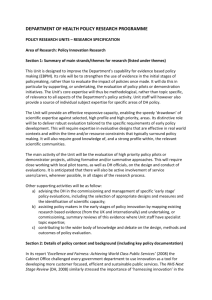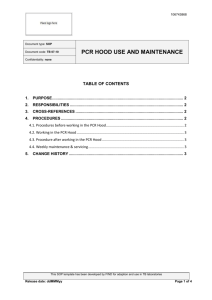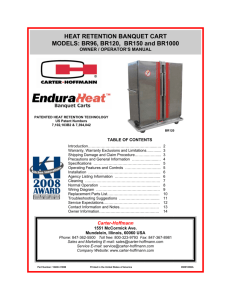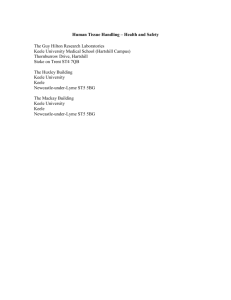Hamilton Regional Laboratory Medicine Program
advertisement
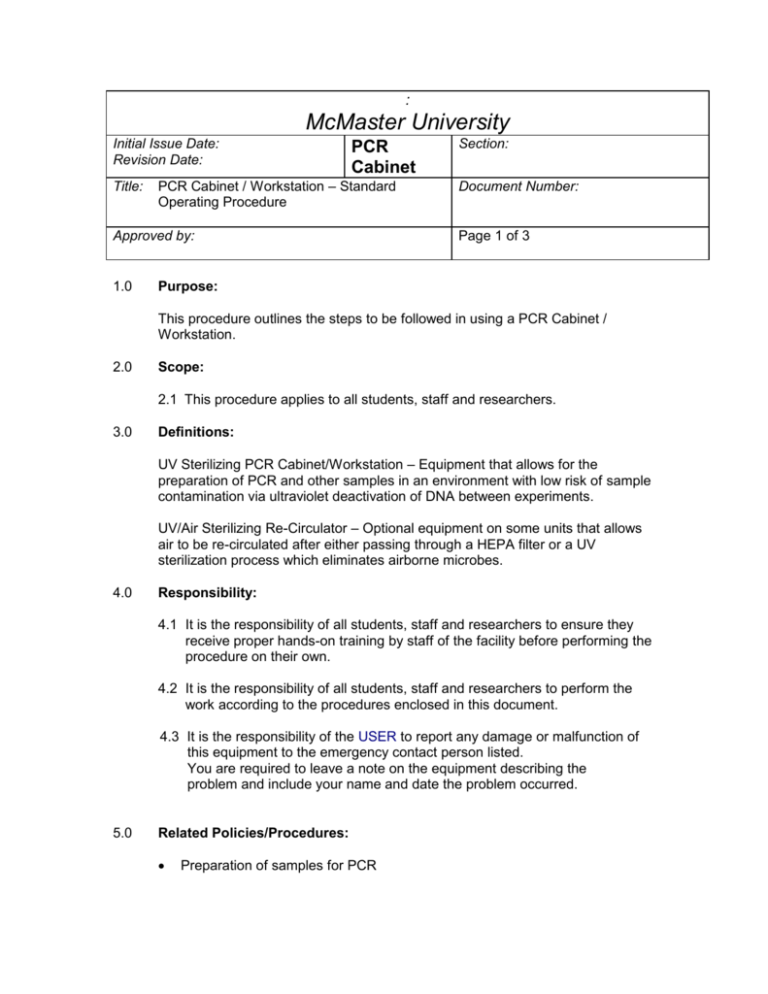
: McMaster University Initial Issue Date: Revision Date: Title: PCR Cabinet PCR Cabinet / Workstation – Standard Operating Procedure Approved by: 1.0 Section: Document Number: Page 1 of 3 Purpose: This procedure outlines the steps to be followed in using a PCR Cabinet / Workstation. 2.0 Scope: 2.1 This procedure applies to all students, staff and researchers. 3.0 Definitions: UV Sterilizing PCR Cabinet/Workstation – Equipment that allows for the preparation of PCR and other samples in an environment with low risk of sample contamination via ultraviolet deactivation of DNA between experiments. UV/Air Sterilizing Re-Circulator – Optional equipment on some units that allows air to be re-circulated after either passing through a HEPA filter or a UV sterilization process which eliminates airborne microbes. 4.0 Responsibility: 4.1 It is the responsibility of all students, staff and researchers to ensure they receive proper hands-on training by staff of the facility before performing the procedure on their own. 4.2 It is the responsibility of all students, staff and researchers to perform the work according to the procedures enclosed in this document. 4.3 It is the responsibility of the USER to report any damage or malfunction of this equipment to the emergency contact person listed. You are required to leave a note on the equipment describing the problem and include your name and date the problem occurred. 5.0 Related Policies/Procedures: Preparation of samples for PCR 6.0 Equipment: Personal protective equipment: latex/nitrile gloves, lab coat, UV protective eyewear or face shield if needed. ____________________________________________________________________________ 7.0 Action/Decision-making Framework: PROCEDURE STEPS 7.1 Pre-use inspection 7.2 Using cabinet WORK INSTRUCTIONS .1 Check: Condition of electrical cord UV light is off Keylock is off (if applicable) RATIONALE To prevent accidental exposure of personnel or samples to UV light. .1 Internal plugs, if provided, may be used for other equipment, which is to be decontaminated between experiments. .2 Equipment plugged into internal plugs should not exceed the maximum recommended amperage. .3 Cabinet is not to be used in place of a biological safety cabinet. 7.3 Operation of UV light .1 (If applicable) Ensure key is completely inserted into the lock. Turn keylock ON. .2 Set timer for appropriate decontamination time. .3 Turn keylock OFF when done. 7.4 White light To prevent sample exposure to UV light. .4 NEVER commence work with UV light on. UV can harm all personnel in vicinity. .4 Keep UV use to a minimum. To minimize crazing of acrylic panels. .5 Use recommended procedures to measure UV emissions at recommended intervals To ensure adequate decontamination is occurring. .1 Keep ON while working. Prevents eye strain. .2 May be on at any time, including decontamination. PROCEDURE STEPS 7.5 Air Recirculation WORK INSTRUCTIONS RATIONALE .1 Not applicable for all units. .2 Turn ON. .3 Keep air vents clear. 7.3 Cleaning and Maintenance For proper air circulation. .1 Cleaning of work station includes making sure it is in the condition it was when you first used it. .2 Unplug before performing any cleaning or maintenance. .3 Clean spills promptly according to appropriate spill protocol. .4 Use a mild detergent and soft cloth. Never use organic compounds, alcohols, ammonia-based cleaners, or abrasive materials. .5 Clean dust from cord and plug pins at least yearly. .6 UV lights must be tested routinely and bulbs changed as needed. 7.5 Safety .1 All those using the equipment must wear the appropriate personal protective equipment. This should include lab coats & gloves. .2 The unit has built-in safety features. Never attempt to override any safety feature. The safety shut-off turns off the UV light when the door is opened. The acrylic door is UV blocking (if at least 0.5 inches thick). In the unlikely event of a malfunction, NEVER expose eyes to UV light without wearing UV blocking glasses. 8.0 As UV lights age, their intensity diminishes, which affects their germicidal activity. Documentation: Even short exposure to UV light can cause damage to unprotected eyes and skin. 9.0 References: Equipment manual 10.0 Developed By in Consultation With: FHSc. Safety Office



